The first fully flat bed I’d ever sat in as a child was one of a Cathay Pacific 747. I thought it was really cool how I could change the seat into a bed at the touch of a button, and I loved the sense of privacy that the seat had as a 4”5’ lad. I remember not understanding why my mother hated the seat, since I wasn’t prone to claustrophobia and didn’t have to take care of my sister. But I’m a growing boy, and unfortunately herringbone seats haven’t grown nearly as fast as I have.
On Saturday I had the chance to try a herringbone seat for the first time in seven years when flying Upper Class between Hong Kong and London. In the meantime, as a premium travel analyst, obviously I’ve been on the lookout for different reports on herringbone seats, as well as their correspondent nicknames – coffin class, prison, etc.. Prior to this flight, the herringbone seat was one of two major business class configurations that I’d yet to try, the other being the Apex Suite. I wanted to see if I liked the product, and where it stacked up against the rest of the configurations I’ve flown in the past.
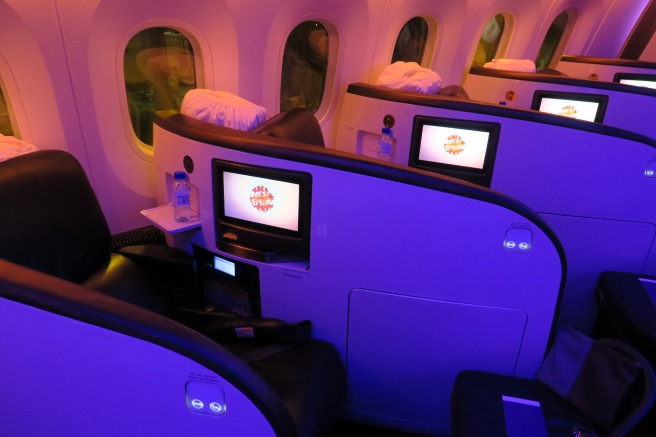 Virgin Atlantic Boeing 787 Upper Class Seats
Virgin Atlantic Boeing 787 Upper Class Seats
I figured I’d break down some of my thoughts on herringbone seats based on my experience in Virgin Atlantic’s Upper Class “suite” (if you can even call it that). While my thoughts of the seat are mostly negative (as expected), it did pleasantly surprise me in a couple of ways.
What are herringbone seats?
For those who are normal people haven’t been in the industry for long, you might not know exactly what herringbone seats are. Herringbone seats are a rather compact business class seat configuration where seats are aligned against the cabin walls and angled towards the aisle. When they were first introduced they were industry leaders (Virgin Atlantic was actually the first airline to introduce herringbone seats onboard their planes), though in the meantime airlines have found more private and comfortable ways to maximise space.
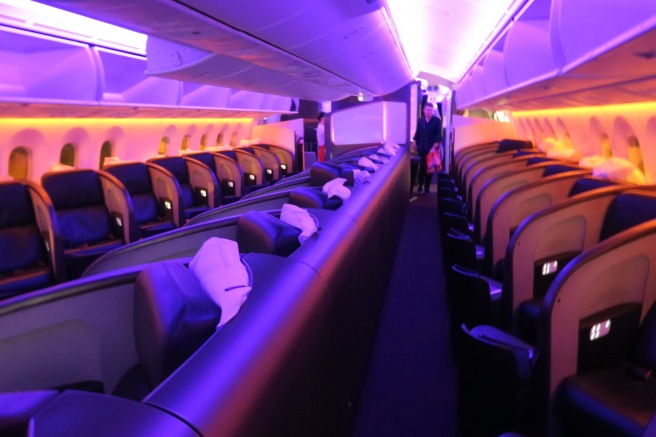 Virgin Atlantic Boeing 787 Upper Class Cabin
Virgin Atlantic Boeing 787 Upper Class Cabin
When other airlines started using herringbone seats Virgin Atlantic actually filed a lawsuit against them, claiming that they owned the patent for the seat. Virgin Atlantic and Air New Zealand still continue to install herringbone seats on their brand new planes (though rumour is that Virgin Atlantic is ditching the herringbone seat for a suite with a door, which will be introduced next year), while Air Canada, Delta and Jet Airways are among the airlines who have these planes on their older aircraft.
Herringbone seats were first known to be ultra-private, though passengers quickly found issues with looking out of the window (since the seat’s angled away from it), as well as talking to other passengers. Furthermore, some people found the seat claustrophobic, due to the walls surrounding the seat. So while the seat used to be industry leading, by now it’s pretty outdated, and instead reverse herringbone seats have become the standard (instead of facing the aisle, seats are angled towards the window).
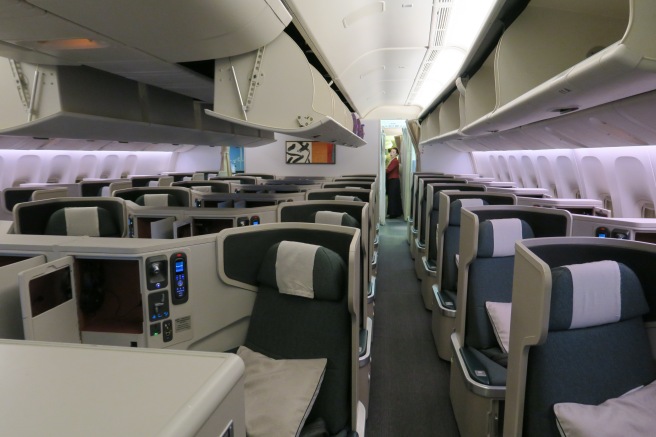 Reverse herringbone configuration on Cathay Pacific
Reverse herringbone configuration on Cathay Pacific
So, how did the seat fare against my expectations?
Herringbone seats are NOT private
The main issue with herringbone seats is that they literally face the aisle. I figured that would translate to a lot of foot traffic, and it did. This was my main concern prior to boarding, though I’m pretty sure I walked around more than most passengers combined. I spent a lot of time at the bar, I changed, I brushed my teeth, etc.. So I wasn’t bothered by the aisle traffic as much as anyone else.
It’s especially notable that Virgin Atlantic has a 1-1-1 configuration on these 787s, and I reserved myself and my dad seats on the left side of the aircraft. Since the seats on the middle of the plane face the right, the seats on the left side face a wall, and there’s also less aisle traffic (since these seats have the aisle to themselves). So we already had more privacy than anyone else seated in the middle aisle, or on the right side.
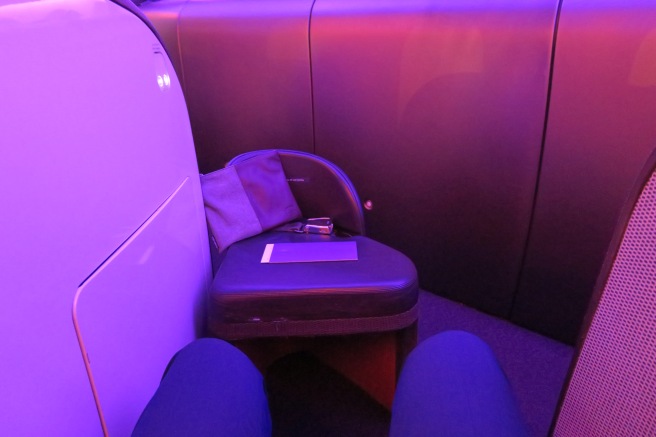 Virgin Atlantic Boeing 787 Upper Class View from Seat 4A
Virgin Atlantic Boeing 787 Upper Class View from Seat 4A
There’s an upside to this, though. It’s actually pretty easy to talk to a travel companion. The key is that you select seats that are in front of one another. My dad was seated in 3A, and I was seated in 4A. All I had to do to talk to him was lean forward slightly, since the seat “walls” weren’t particularly tall. If anything, it’s easier to talk to your travel companion in this seat than in any sort of staggered configuration (unless you select the honeymoon seats, of course – click on this link to read a review of a business class product with a staggered configuration, and to know more about honeymoon seats).
You have to give herringbone seats credit for being the only configuration out there where you can sit next to someone and both have a window seat (even though neither of you can easily look out of it).
Herringbone seats have zero storage
There’s no avoiding this caveat to herringbone seats – the only storage space you’ll get at all is below the ottoman. It’s been a while since I’ve sat in a business class seat where I had to stow my laptop in the overhead bin before I went to sleep. Virgin Atlantic actually installed a storage platform on this iteration of their business class seat, located on the left side of the seat. It’s not a lot; though since storage space was otherwise nonexistent, this proved very useful for placing drinks, as well as my watch, phone and glasses when I went to bed.
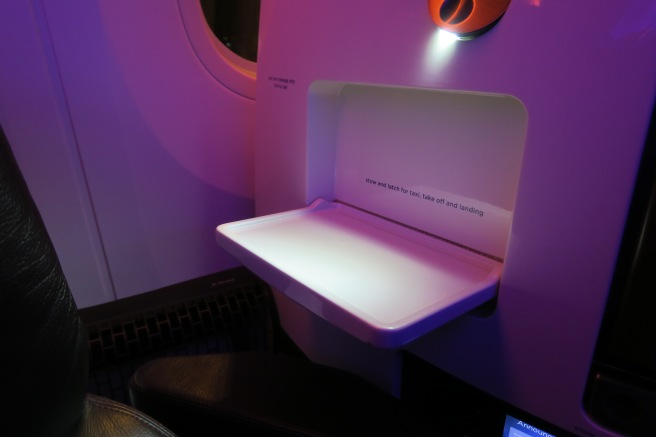 Virgin Atlantic Boeing 787 Upper Class Storage Platform
Virgin Atlantic Boeing 787 Upper Class Storage Platform
It sure wasn’t the best setup, though the plus side is that since there’s a 1-1-1 configuration, there’s a pretty good chance you’ll have the overhead bin to yourself (both my dad and I got my own overhead bin). Since Virgin Atlantic chose not to get rid of the overhead bins above the middle seats, us passengers on the left aisle actually had two overhead bins to choose from, which was sweet – I didn’t have a particular need for that, though. So yeah, on 1-1-1 configurations, always check the seatmap beforehand, and select a window seat that faces a wall.
Herringbone seats aren’t the most spacious, either
While the cabin walls weren’t high, I’d be lying if I said I didn’t feel confined by the cabin walls. At the end of the day herringbone seats aren’t the widest, and after a while I went to work at the bar so I could be exposed to some open air. While you won’t get half as much space in an economy or even premium economy seat, there are much more spacious configurations out there, such as reverse herringbone seats; they don’t require much extra space either, since most airlines fit 30 reverse herringbone seats between doors 1 and 2 on their 787-9s, whereas Virgin Atlantic fits 31 herringbone seats. That’s a testament to how much engineering has allowed airplane seating to move forward over the past years.
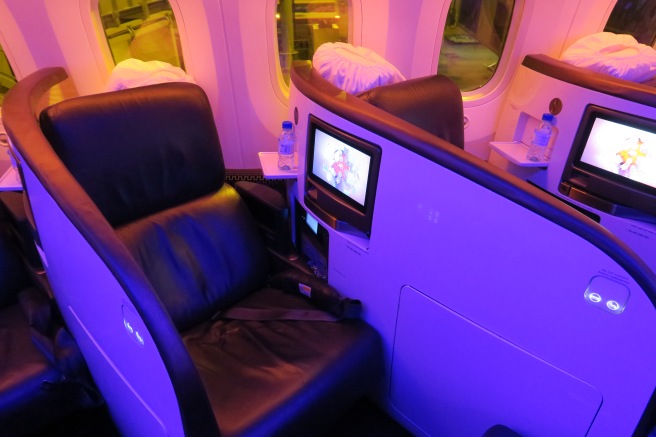 Herringbone seats have rather confining seat walls
Herringbone seats have rather confining seat walls
Virgin Atlantic actually curved their seat walls so space could be maximised in bed mode. While the bed didn’t feel too narrow, I couldn’t curl up into a fetal position with any ease, which I can do in more “modern” configurations. However, since your head’s pretty far from the aisle in bed mode, you do have a certain degree of privacy.
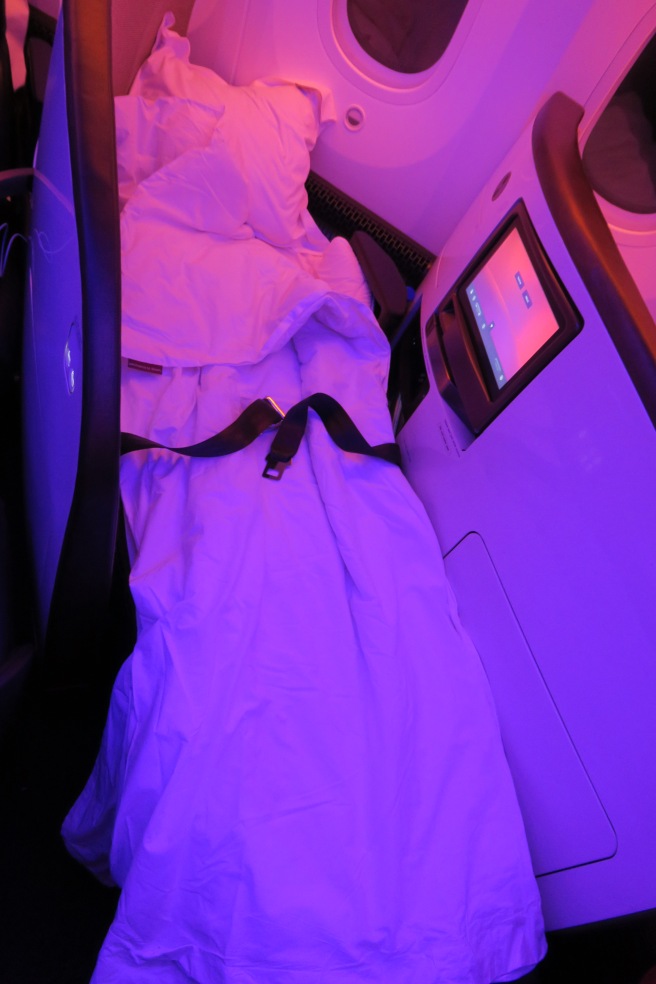 Virgin Atlantic Boeing 787 Upper Class Bed
Virgin Atlantic Boeing 787 Upper Class Bed
How do herringbone seats fare against the rest?
There’s no question that herringbone seats aren’t as good as more modern configurations such as staggered seats or reverse herringbone seats. In the meantime engineering has allowed airline seats to be more space-efficient, maximising space, storage, and practicality for passengers, while also being able to maximise payload. Herringbone seats were introduced almost 15 years ago, and simply can’t compare to these newer configurations that have appeared in the meantime.
However, I’d still prefer a herringbone seat over a standard, forward-facing fully flat business class seat, actually. While it’s much easier to look out of the window in a forward-facing business class seat, direct aisle access is still a factor that I can’t overlook. Neither configuration affords much storage space, so I appreciate that I don’t have to disturb anybody when I leave my seat in a herringbone configuration, whether I’m using the lavatory or retrieving something from the overhead bin.
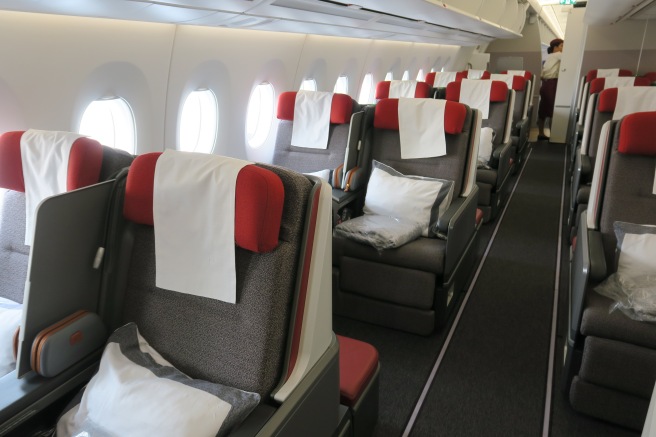 LATAM’s forward-facing A350 business class seat
LATAM’s forward-facing A350 business class seat
Bottom Line
This was my first time in a herringbone seat in seven years, so obviously some of these claims I made could be unfounded. For example, while it’s easy to talk to a companion in Virgin Atlantic’s business class seat, maybe the same can’t be said for a similar configuration on, say, Delta – I wouldn’t know prior to trying their products too.
However, being able to try a rather first-generation nonstandard business class configuration allowed me to truly see how far airline seating has come. Modern engineering has allowed airplanes to install payload-efficient, spacious and comfortable seats. It’s crazy that the industry leaders have gone from herringbone seats like these to legitimate suites with doors in a matter of 10 years.
For now, though, herringbone seats are still a decent way to fly, even if the product is outdated, and there’s limited storage space and privacy compared to more modern configurations. I can’t wait to see what’s in store for premium airline seating in the future.
What’s your favourite airplane seat configuration?